My Journey in Ireland (Mo Thuras in Éirinn) - Part I
Dublin for a day, turning 25 in Belfast, and the hills of Derry...
The drive to Denver Airport was stormy; thick, dark clouds laced with intermittent tendrils of lightning overhanging the Front Range. I was nervous, but not about the weather. The weather I found comforting. Storms make me feel more alive. I was nervous about the journey itself. I had never been outside Colorado alone before, let alone outside the US. Change sizzled in the air, and as I pulled my knees up to my chest in the passenger seat, I tried to steady myself by breathing slowly. My mom drove, her presence steadfast and calming. We’d left home at 4pm, my flight was at seven. When we arrived, the parking lot was full, so she couldn’t go in with me. We said our goodbyes at the terminal entrance, then I went inside to check in and go through security. A couple hours later, I was in my seat.
If you’d have told me a couple years ago that I’d be traveling to Ireland for the first time by myself, I might have looked wistfully into the distance and talked about that being “the dream.” I don’t know if it was the election, my newfound confidence from my job as a middle school mentor, or some other third thing that kicked my ambition into high gear, but this year I did something that I’ve never done before: I manifested. Telling myself and anyone who’d listen that I was going to Ireland at the end of the year.
Things fell into place after that, and I took charge of my own journey: looking up hotels, buying plane and train tickets, booking visits to exhibits, you name it. Things I’d never done before on my own, had only ever watched other people do, I was suddenly taking on with relative ease. With invaluable advice from my parents (particularly my mom), friends, and coworkers, I had almost everything I needed by the time I boarded Aer Lingus flight EI58. I was going to Ireland.
After the plane took off, I wrote in my journal:
The clouds are so still this high up. Thin sheets of blue-gray, underscored by the red-gold sunset over the mountains. Colorado passes below like a slow-moving river; even the lights of towns and homes are like fish lounging at the bottom. I hope I’ll sleep tonight. I hope tomorrow is clear and cool.
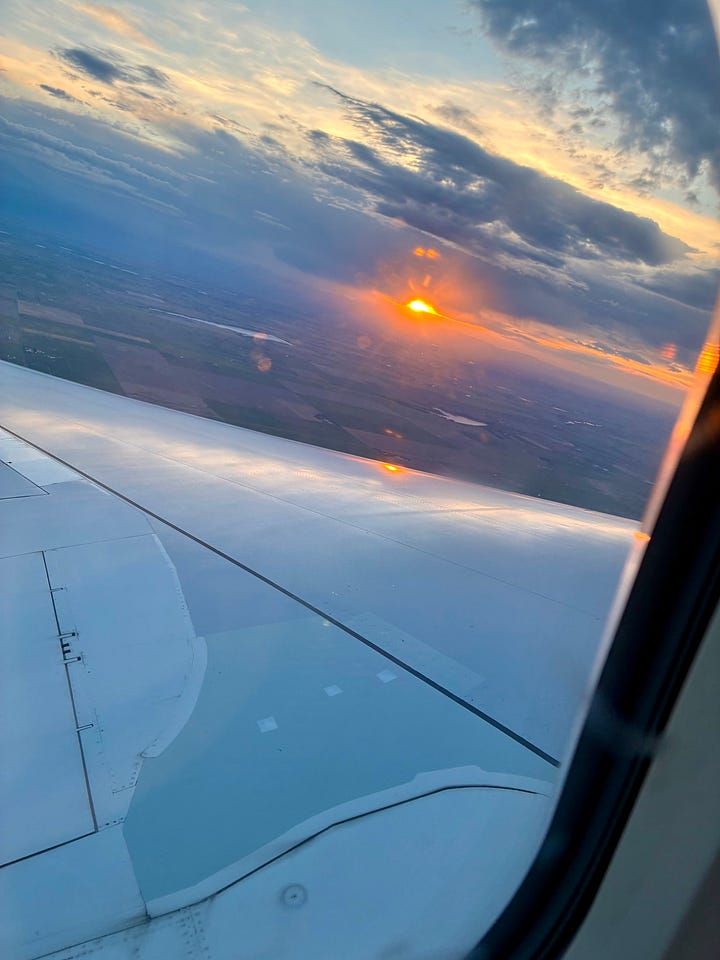
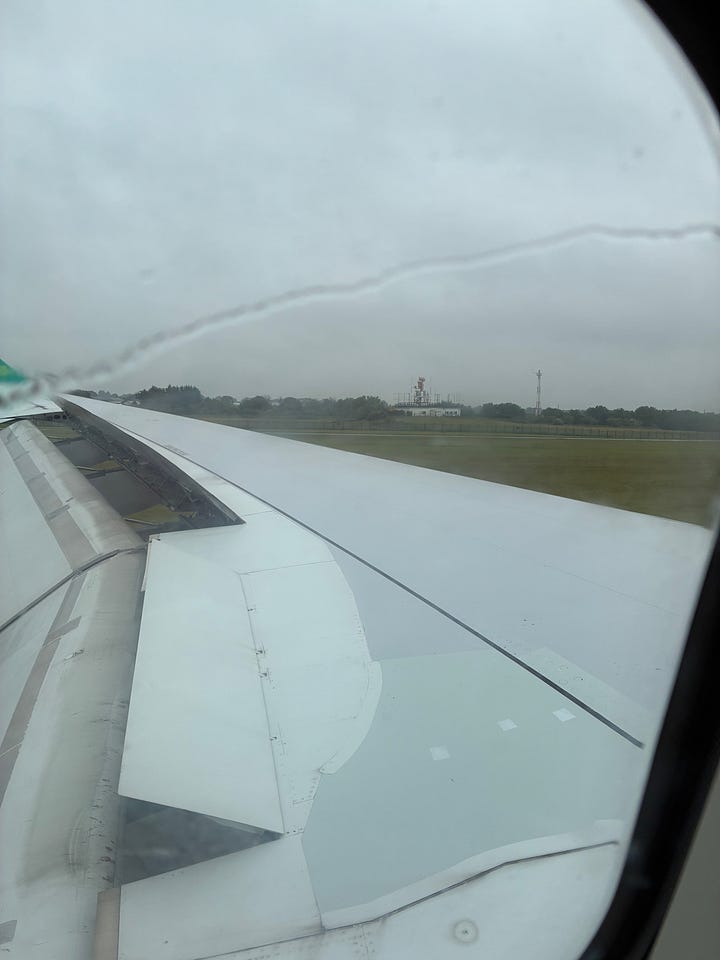
Dublin (Baile Átha Cliath)
Arrival in Dublin quickly replaced nerves with excitement. I gave myself over to the whimsy of the situation I was in, looking around wide-eyed and child-like before I even left the airport. Got myself a bus ticket and I was on my way to the city.
If I had to describe my first two days in Ireland in one word, it would be: wet. Fliuch. Rain coated the windows in shimmering shades of green and gray. I texted my Irish language group: “my goodness what gorgeous rainy weather!! Tá sé stoirmiúil agus fluich! Tá sé ag cur báistí. Is aoibhinn liom!!!” The second I stepped off that bus, my Trial by Water began. The thing about being on an island at this latitude in the midst of summer is that when it rains, it does not stop for a while. Rain like this also creates its own kind of heat, regardless of the atmospheric temperature. By the time I got where I was going, I couldn’t tell what was rain and what was sweat.
Regardless of these conditions, I couldn’t have been more thrilled to be where I was. I’d dreamt of going to Ireland my entire life, and now I was here! Dublin in all its cosmopolitan bustle, all its traffic and movement, truly is the beating heart of the Republic.
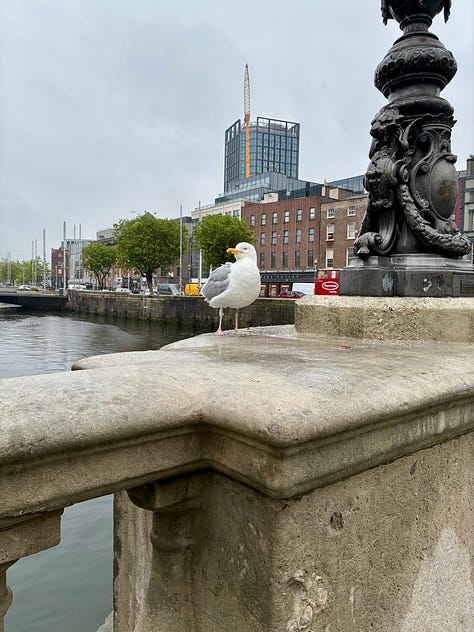
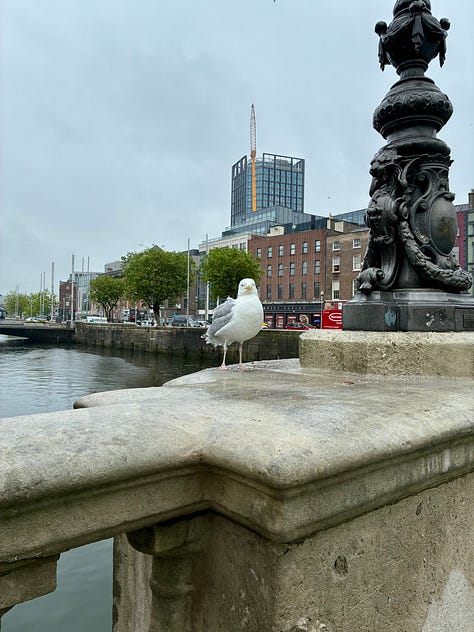
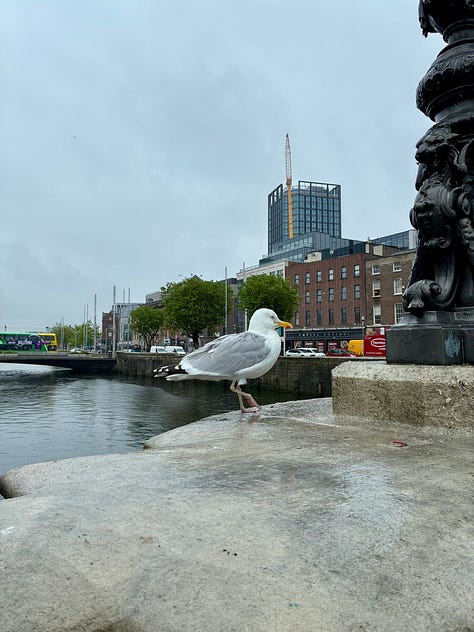
Despite being over 1,000 years old, Dublin is an overwhelmingly youthful city. I suspected that a large percentage of the people were there for work or to attend Trinity College, where I would be staying for the equivalent of a day at one of the dorms they open to the public in the summer. Although I had a map of the campus, with directions from a very helpful receptionist, I still got a little lost trying to find my room. Luckily, I’m not as awkward with strangers as I used to be, and a nice woman, who sounded like she was from England, helped me out. A reliance on the kindness of strangers is hardly ever an issue in Ireland.
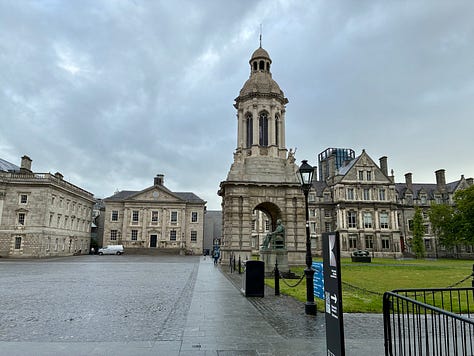
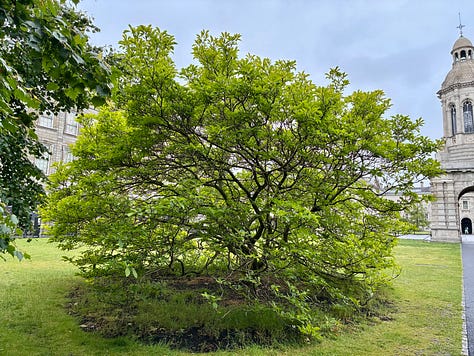
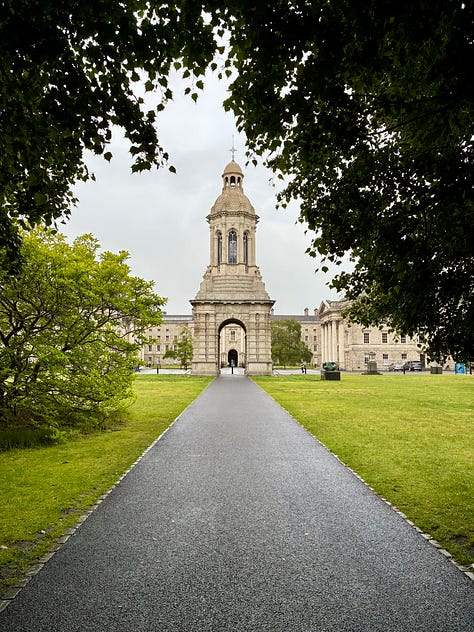
Once I got settled, I took a much-needed shower, then scrounged around the campus for some dinner (which came in the form of a veggie wrap from a cafe a short walk from my building), all the while trying and mostly failing to keep myself dry. During this trip I ended up using a hair dryer, which I haven’t been comfortable using in literal years. Turns out it’s pretty easy, especially when you’re mainly using it as a makeshift fan. If my mom was there, she’d probably say something like “See? Told ya.”
I felt so oddly normal for being completely on my own. I had shelter and food, I was safe, and I had got myself there. On my own. If anything, I was a little bit bored. With nothing much else to do at the end of a whirlwind day, I wrote:
What to say after months of nothing?
On the plane I didn’t sleep at all. When I landed in Dublin it was raining. Clouds so thick we couldn’t see the ground until we nearly touched it.
Everything was gorgeously wet today. Wet that hung close and lingered like a heavy kiss. Thick drops falling from shop awnings to slap the cobble stones below.
By the time I got to my room at Trinity College I was soaked with sweat and rain, despite my mother’s coat and umbrella. I spent most of the day walking under an umbrella. It hasn’t quite sunk in where I am, the fact that I’m alone. I felt it more before I left. The fear isn’t there now.
It’s hard not to soak up this city when there’s so much of it around you: the buildings, the streets, the people. Everyone is so different from one another, and yet they all seem to move with similar purpose. A gravitational pull that keeps the city flowing like the River Liffey through its heart.
I thought I would melt under the weight of all that wetness, but as I settled in a cool calm descended on me. Now I feel the air for what it is: a song sung by many human voices, sung by the cry of the massive seagulls and magpies that home this place.
My ears are still popping despite being on solid ground now. Must be the lower altitude.
I’m eating dinner on my bed, listening to the gray city drone outside. Waiting to finally fall asleep.
The Book of Kells exhibit was stunning. Also balmy, since the whole room has to be kept at a certain humidity in order to preserve the book. I took pictures of everything I could but the actual Book of Kells, as photography of the book itself is strictly prohibited.
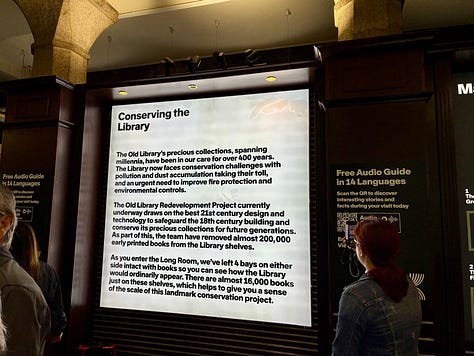
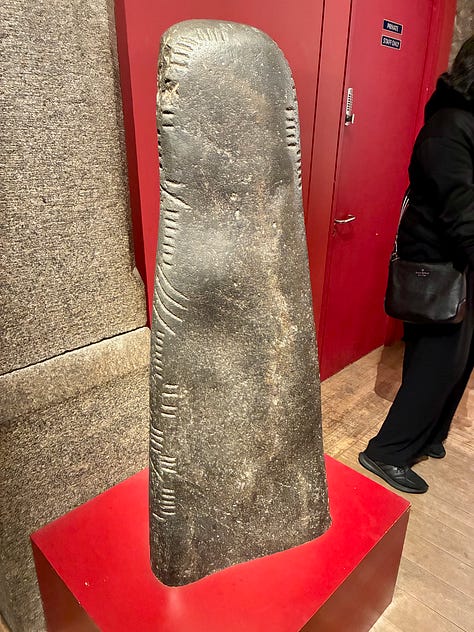
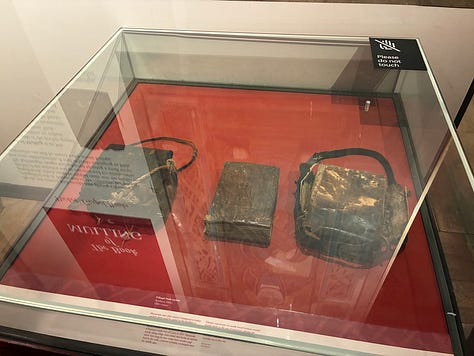
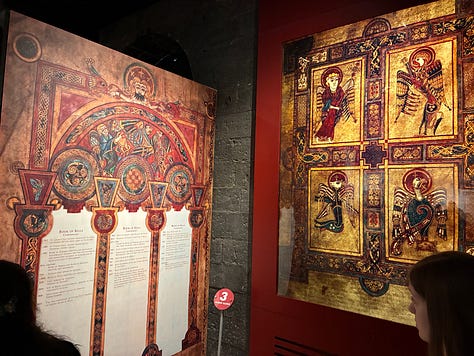
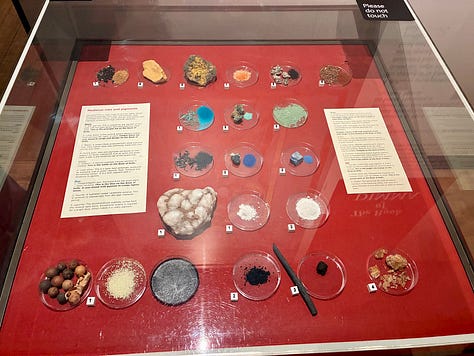
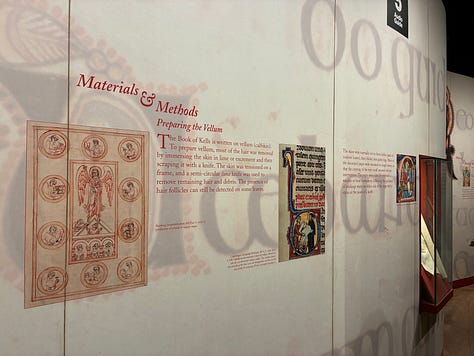
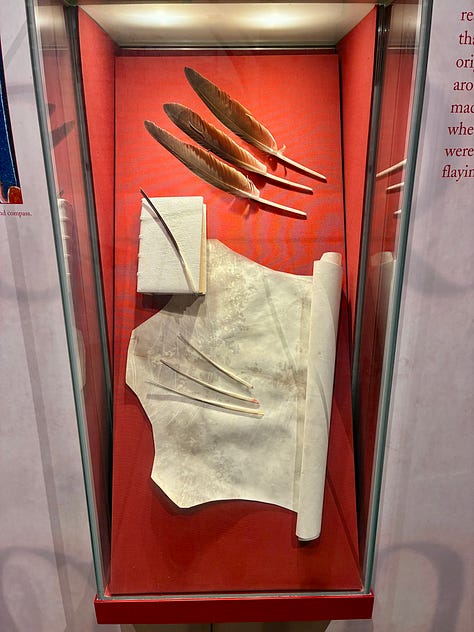
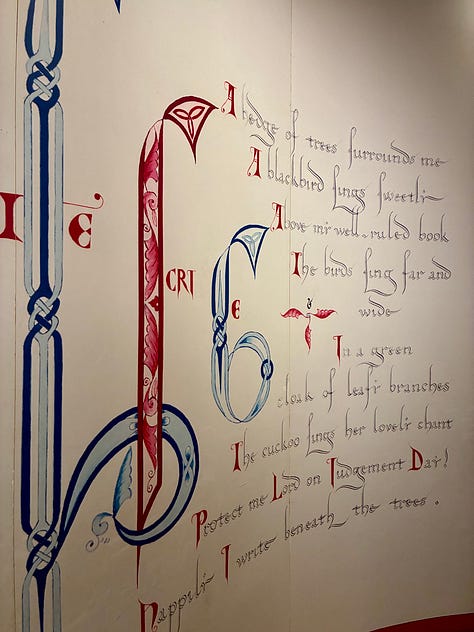
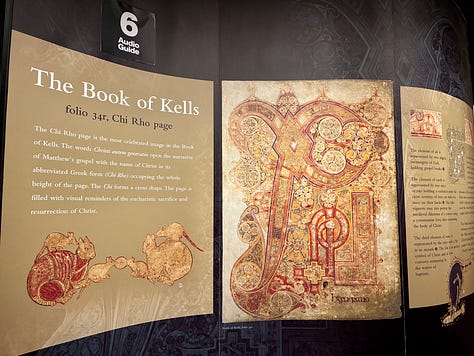
After that, the exhibit led into Trinity College’s Old Library. An over 400-year-old, barrel-vaulted space referred to as the “Long Room”—spanning nearly 65 meters, or 213 feet—it is the largest library in Ireland and, arguably, one of the most impressive in Europe. Under normal circumstances the shelves would be filled with books (over 6 million volumes, in fact). However, as I’m writing it is currently undergoing an extensive restoration project, and a large number of their volumes had been taken out. Even nearly empty, the Old Library truly is a sight to behold. Lined on either side with busts of some of the greatest writers and thinkers in Western history, including Socrates, Shakespeare, and Wollstonecraft, you’ll also find copies of the original 1916 Irish Proclamation of Independence and the Brian Boru harp, which is the oldest surviving harp in Ireland.
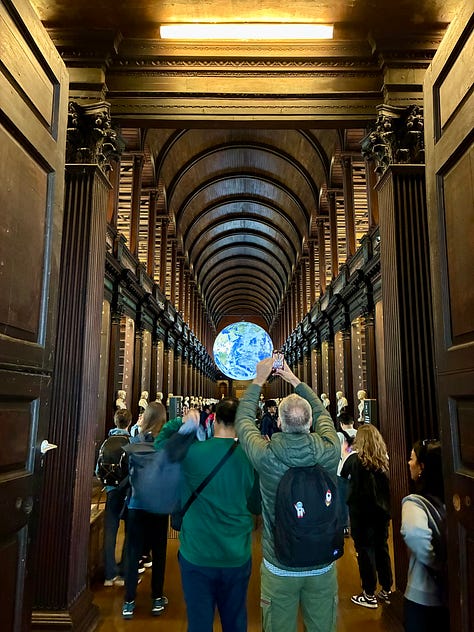
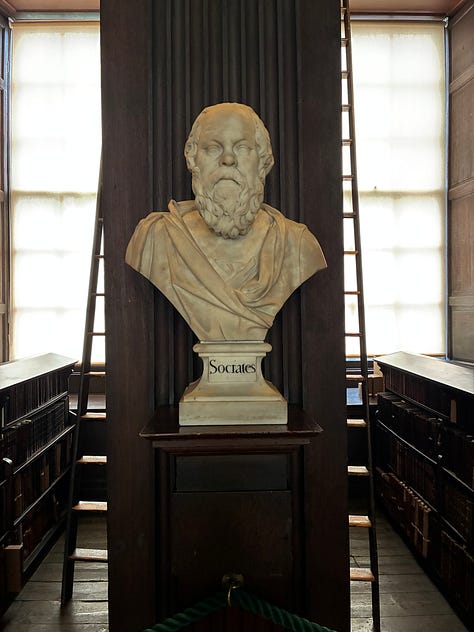
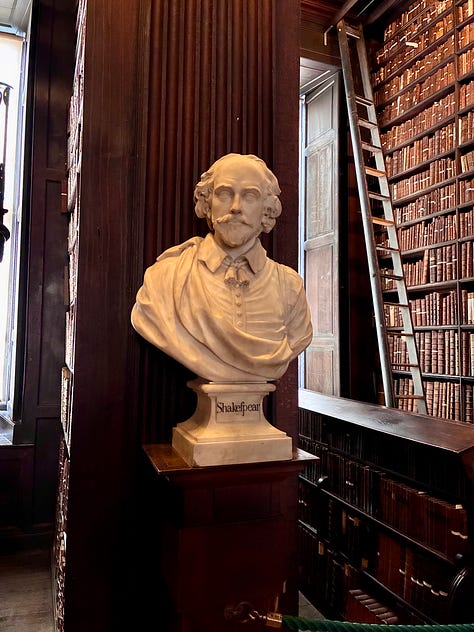
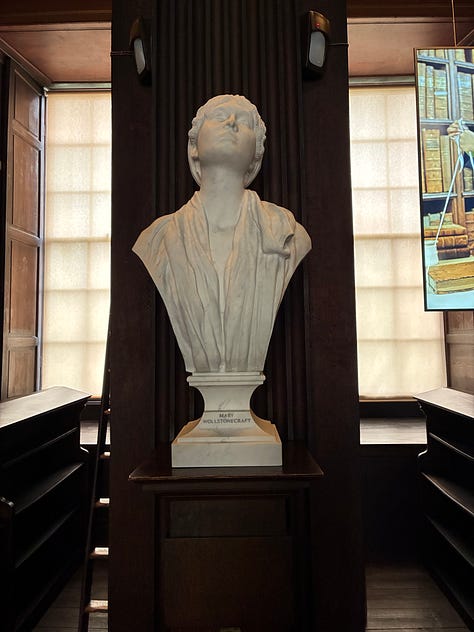
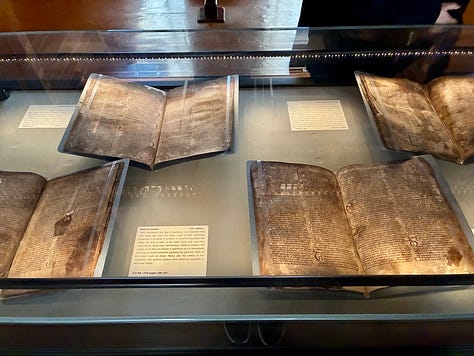
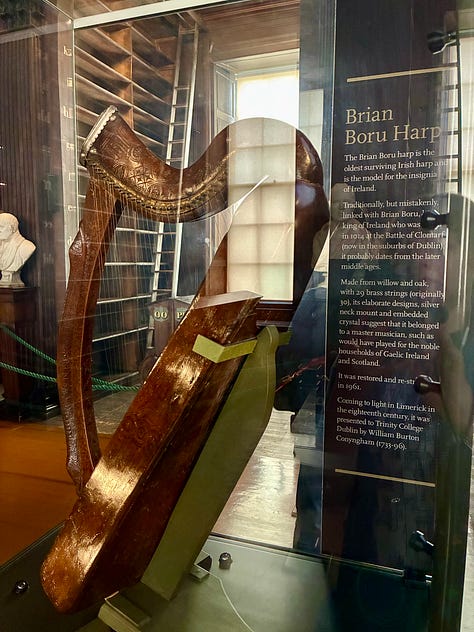
Also featured in the Long Room is the art installation Gaia, created by Luke Jerram. Impossible not to notice upon entering the library, this 6-meter-diameter orb of the earth’s surface, superimposed with 120dpi detailed NASA imagery, hangs in the center of the room, spinning slowly. According to its description, the purpose of this installation is to instill in viewers “a feeling of awe for the planet, a profound understanding of the interconnection of all life, and a renewed sense of responsibility for taking care of the environment. Jerram’s intention for Gaia to highlight the beauty and fragility of the Earth chimes with that of the Old Library Redevelopment Project to safeguard the 18th century building and conserve its precious collections for future generations.” She dances like a glamour, impossible in its contrast against the carved mahogany world of man, yet strangely perfect in its place amongst the leather and ink of humankind’s inspiration.
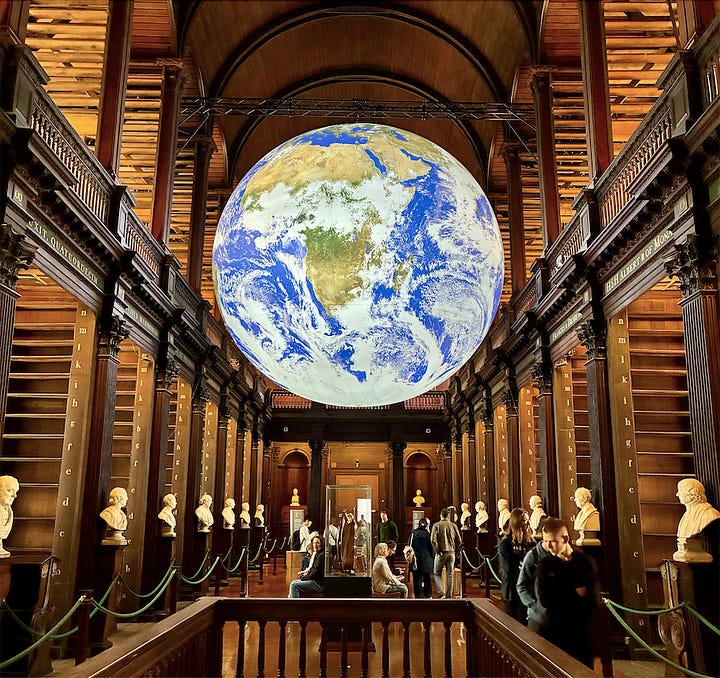

I’d planned to visit the Museum of Archaeology, which has free admission and is only a short walk from the college, but by the time I left the Kells exhibit, it was getting late and I needed time to find the train station. As it turned out, this was a wise decision on my part. Despite notable improvement in weather and absence of rain for the first time in over 24 hours, I checked out of my room at Trinity the exact same way I’d checked in: drenched in sweat, as if I’d just run a marathon (I hadn’t). Then I walked the 0.2 miles from Trinity to Eden Quay to wait for a bus that would, hopefully, deposit me right outside of Connolly Station.
It became quickly apparent that I should’ve put in for a transit pass; the fare is about 2 euro per person (though it varies depending on how far you’re going), but I had all of my cash stuffed into a pocket in the underbelly of my suitcase. I barely had time to start panicking before the bus driver, likely trying to keep things moving, told me to just take a seat; yet again, the interminable blessing of Irish grace intervening on my behalf.
At Connolly I grabbed a quick lunch and stopped to charge my phone at a Pret
A Manger1. By the time I finished my hot cup of tomato bisque, I was fully dry and proud to have had a healthy lunch that (hopefully) wouldn’t aggravate my extremely mild oral thrush. There’s a certain feeling experienced by the young adult who, for the first time, finds themselves completely on their own and, shockingly, not fucking it up. It’s not quite euphoric, but close enough. I mean I’ve never done drugs, but for an insecure, socially anxious youth, maybe this is better. Forgetting about nitty-gritty’s like taxes and jobs and jury duty, you start to feel like maybe you aren’t so bad at this whole “adulting” business. But I digress.
This was the most exciting leg of my journey. Almost everyone I’ve met who’s visited Ireland will talk about Dublin and its environs, or the rest of the south, but for over a year I wanted nothing more than to be in the North of Ireland. I had been populating my mental landscape with things like Derry Girls, Say Nothing (first the mini series, then the book) and anything to do with Anthony Boyle2. So, finally boarding the train and finding my pre-paid seat, it’s safe to say I was buzzing. I needed to keep my expectations in check. I wasn’t going to
Disney Land or some mystical place beyond the veil of time. As a tourist, it’s easy to forget that the places you visit are other people’s homes. What’s great about going to a place like Belfast is, there’s plenty to see, but not a lot of it is flashy or iconic. You’re not really there to see grand houses or monuments or shopping centers; you’re there to see the people. To see where they live. Get a
sense of the history of the place from the pedestrian everyday.
The real charm and pulse of the North of Ireland is its people because they all carry its history. This is where I’d been buzzing to go for months. I was finally on my way.
I am learning that the earth is the earth. One place can look and feel so wildly different and so strangely similar to another. I can’t deny how dearly my heart has thirsted for green like this, all around me, wet and shimmering, overgrowing, perfect. Rolling hills of green and gray and brown and blue pass by my window. I wish I could spend the rest of my life riding a train across this land.
Belfast (Béal Feirste)
Ah, Belfast. Rough and tumble city with a thousand rough and tumble charms.
Birthplace of the Titanic. Battlefield of the Troubles. Home of…the DeLorean? In so many ways, this city is a special place, and not just because of its tragic moments that continue to reverberate to this day. It is a divided city, like a lot of places in the North of Ireland, though you might not be aware of that if you stayed in the city center. It is also a culturally vibrant and energetic city. I felt this energy the minute I stepped off the train.
Every city on earth has its own unique texture. You only really get a sense for it when you’ve been there. Belfast’s brick and concrete walls, painted over by graffiti artists over the decades, may still retain traces of soot from its varied past, but the city as a whole has a kind of rusty shine that comes from within. It’s a light that has been kept alive by both conflict and commiseration. Tears and laughter. The people there are tough, but rarely unkind. Salt of the Earth in its truest sense.
Having walked all the way from the train station to the hotel with my suitcase and carry-on in tow, I arrived at House Belfast, yet again, drenched in sweat. House Belfast is a small but well-known hotel in central Belfast, nestled in the cosmopolitan stretch of Botanic Avenue, amidst culinary establishments that range from Mexican, to Indian, to Asian fusion, to Subway. The staff at House Belfast is as lovely and charming as its Bohemian interior, and were incredibly patient with me while I figured out how to pay for my room3, dripping salt in their lobby.
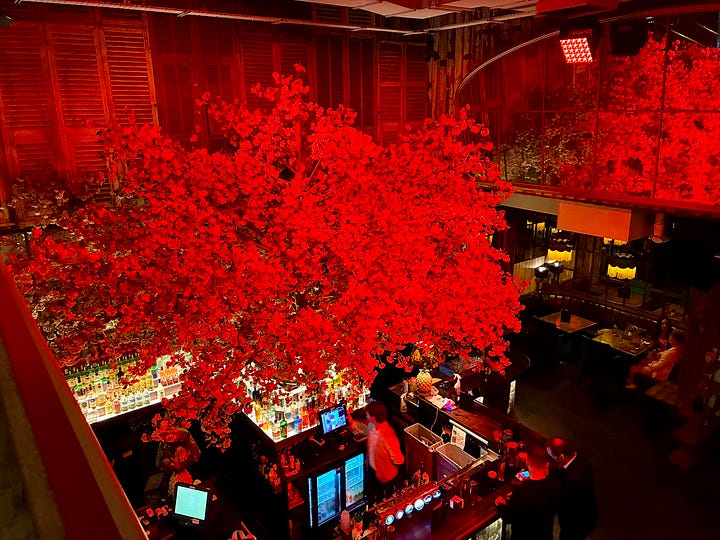
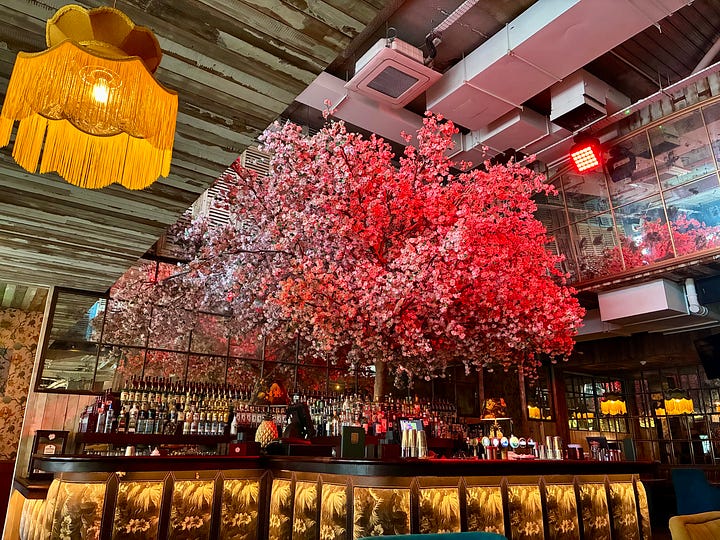
Towards the end of my first day in Belfast, I decided to get on a bus bound for the Falls Road. For those who aren’t familiar with the history of the Troubles, the Falls is an area of West Belfast occupied primarily by Catholics, and while the Troubles were in full swing, it was one of two major neighborhoods which embodied the deep division within this community. The other neighborhood, Shankhill Road, is the predominantly Protestant side of town. The root reason for the outbreak of violence that would become known as “the Troubles” was the historic discrimination and disenfranchisement of Irish Catholics living in the North of Ireland. For around 800 years, the island had been under English rule until the Irish War of Independence (1919-1921). At the end of this war the Irish Free State was able to establish itself with 26 counties out of the island’s total of 32. The remaining six stayed under British rule.
That first day, I really wanted to get a glimpse of the Gaeltacht Quarter4. I got off the bus at Dunville Park and read the sign that said “Páirc Dunville, An Cheathrú Ghaeltachta (The Gaeltacht Quarter).” I took a walk around the park and observed that it was very similar to many of the city parks we have in Denver. Children played on the grass and jungle gym, just like they would anywhere else in the world. At the center of the park stood a weathered stone fountain that looked like a remnant from the turn of the century, its surface chipped and tanned. Walking a couple blocks further down the road, I found the Cultúrlann (Cultural Center).
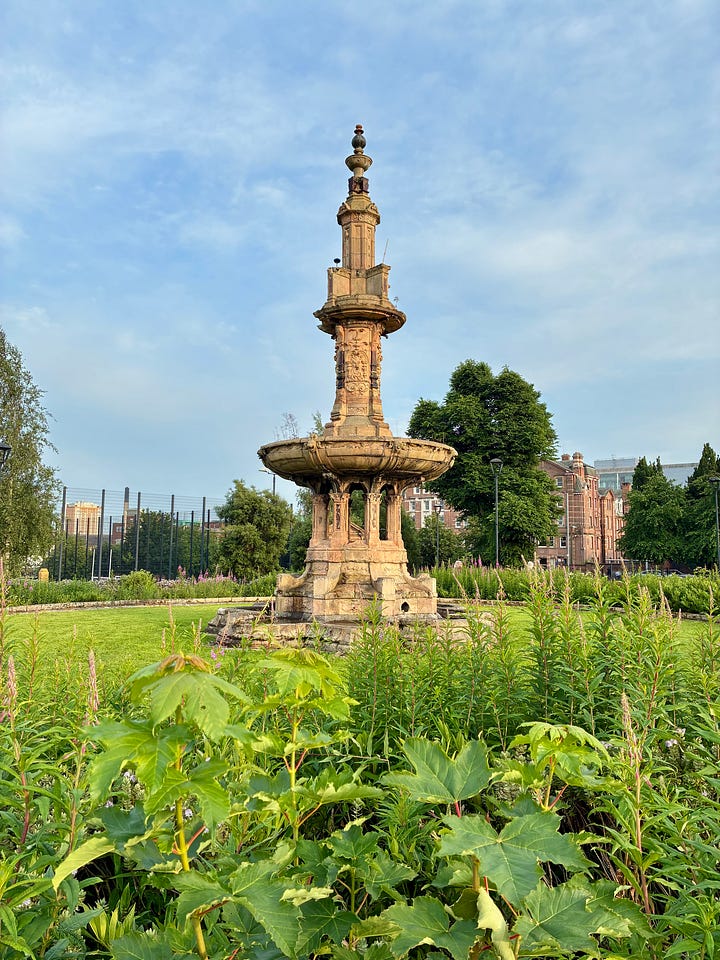
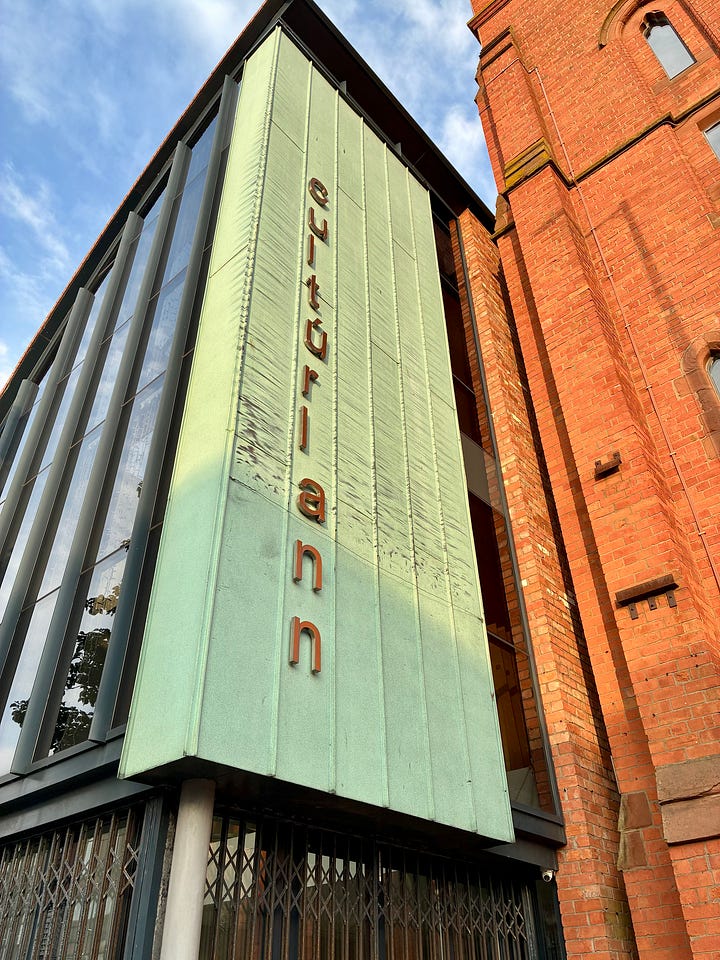
For those who don’t know, Cultúrlann McAdam Ó Fiaich (McAdam Ó Fiaich Cultural Center) is at the epicenter of Irish language culture and education in the North of Ireland, and is considered “the hub of Belfast’s vibrant and fast growing Irish language community.” Originally built as a Presbyterian church in the 19th century, it closed in 1982 and was then leased to a group of Irish language activists in 1991, who named it after Irish language pioneers Robert McAdam and Cardinal Tomás Ó Fiaich. Today it houses a bookshop, a tourist information point, an art gallery, a theater, and Raidió Fáilte HQ. (See photos of An Cultúrlann landmark sign below for more information.)
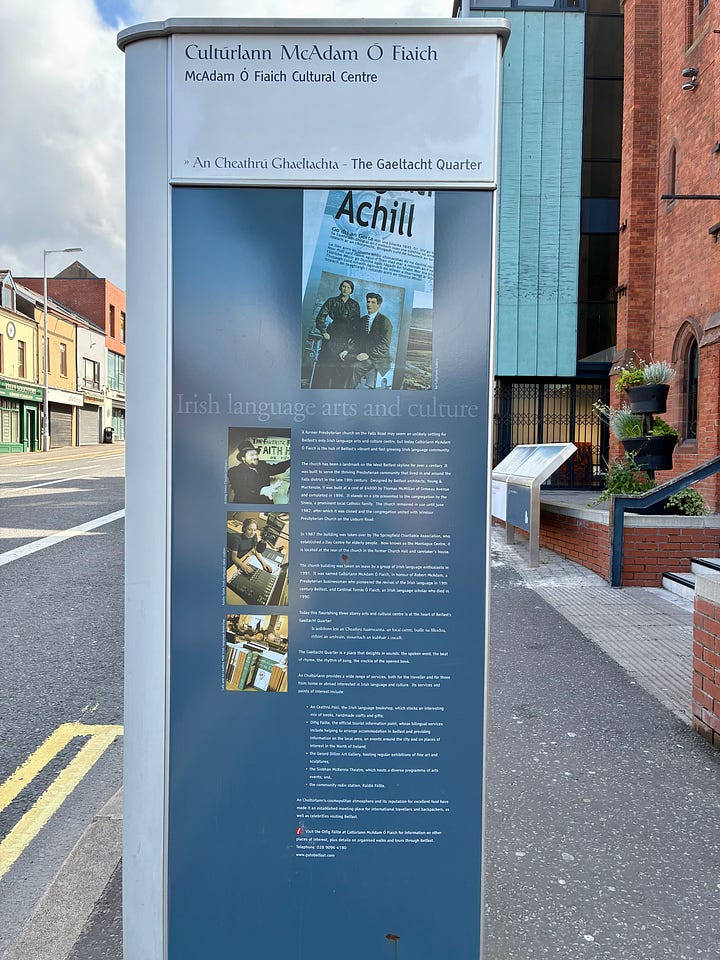
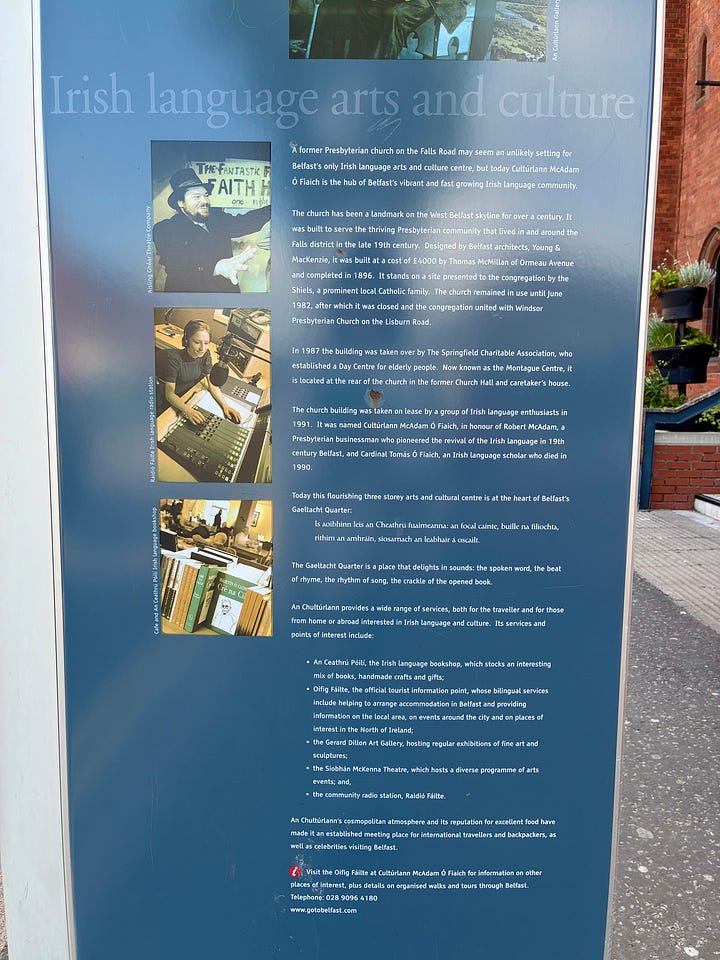
“Is aoibhinn leis an Cheathrú fuaimeanna: an focal cainte, buille na filiochta, rithim an amhráin, siosarnach an leabhair á oscailt.”
“The Gaeltacht Quarter is a place that delights in sounds: the spoken word, the beat of rhyme, the rhythm of song, the crackle of the opened book.”
On my way back, I passed by St. Mary’s University College, one of the filming locations used to shoot the exterior of Our Lady Immaculate College in Derry Girls. The perfect ending to my first day in the North of Ireland.
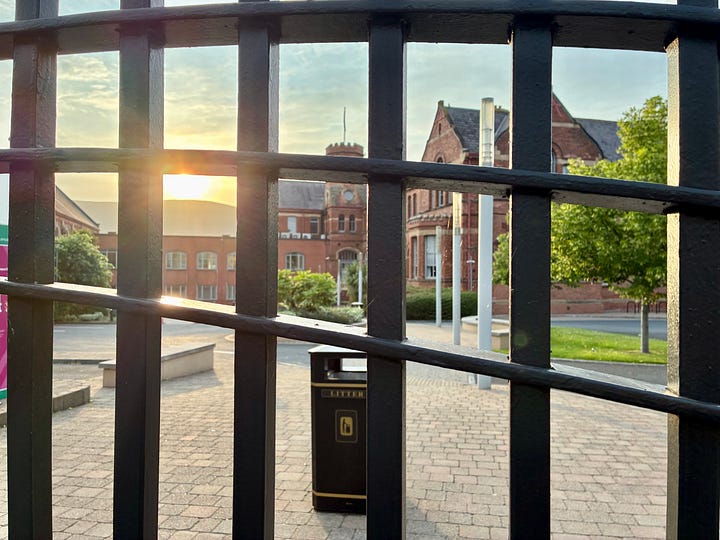
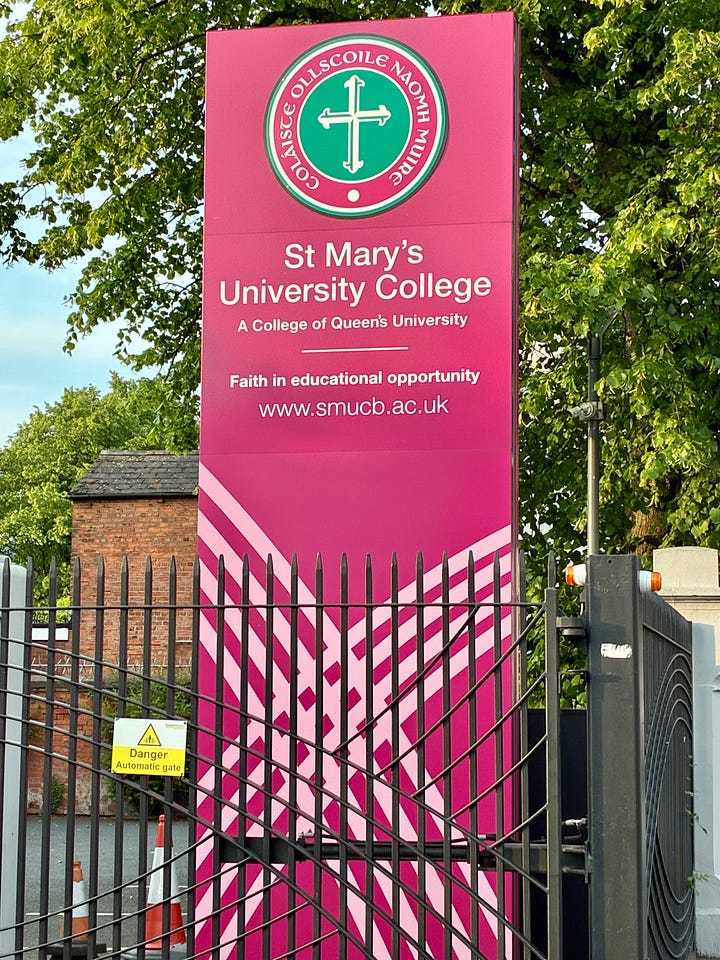
To be continued…
If you aren’t familiar with comedian James Acaster’s hilarious Pret A Manger story, you probably won’t get why this was funny to me.
2025 IFTA Rising Star Award winner, criminally underrated actor, and my current celebrity crush.
It turned out I didn’t have quite enough funds left in my Capital One card to cover the room, so my mom offered to pay it for me over the phone.
An area of the city where Gaeilge (Irish) is the primary language. English is still spoken there, but the intent is to recognize the cultural legitimacy of Ireland’s native language and have a dedicated place where it can be preserved as part of everyday life.











Like we are there with you. Stellar writing about what is obviously deeply moving travel for you. More will surface, I'm sure---we thirst (your word, SO good) for your updating!
Excellent read! Loved it💖